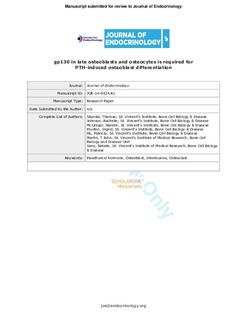| dc.contributor.author | Standal, Therese | |
| dc.contributor.author | Johnson, Rachelle | |
| dc.contributor.author | McGregor, Narelle | |
| dc.contributor.author | Poulton, Ingrid | |
| dc.contributor.author | Ho, Patricia W M | |
| dc.contributor.author | Martin, T. John | |
| dc.contributor.author | Sims, Natalie | |
| dc.date.accessioned | 2017-12-06T13:26:17Z | |
| dc.date.available | 2017-12-06T13:26:17Z | |
| dc.date.created | 2015-01-19T11:00:34Z | |
| dc.date.issued | 2014 | |
| dc.identifier.citation | Journal of Endocrinology. 2014, 223 (2), 181-190. | nb_NO |
| dc.identifier.issn | 0022-0795 | |
| dc.identifier.uri | http://hdl.handle.net/11250/2469406 | |
| dc.description.abstract | Parathyroid hormone (PTH) treatment stimulates osteoblast differentiation and bone formation, and is the only currently approved anabolic therapy for osteoporosis. In cells of the osteoblast lineage, PTH also stimulates the expression of members of the interleukin 6 (IL-6) cytokine superfamily. Although the similarity of gene targets regulated by these cytokines and PTH suggest cooperative action, the dependence of PTH anabolic action on IL-6 cytokine signaling is unknown. To determine whether cytokine signaling in the osteocyte through glycoprotein 130 (gp130), the common IL-6 superfamily receptor subunit, is required for PTH anabolic action, male mice with conditional gp130 deletion in osteocytes (Dmp1Cre.gp130f/f) and littermate controls (Dmp1Cre.gp130w/w) were treated with hPTH(1–34) (30 μg/kg 5× per week for 5 weeks). PTH dramatically increased bone formation in Dmp1Cre.gp130w/w mice, as indicated by elevated osteoblast number, osteoid surface, mineralizing surface, and increased serum N-terminal propeptide of type 1 collagen (P1NP). However, in mice with Dmp1Cre-directed deletion of gp130, PTH treatment changed none of these parameters. Impaired PTH anabolic action was associated with a 50% reduction in Pth1r mRNA levels in Dmp1Cre.gp130f/f femora compared with Dmp1Cre.gp130w/w. Furthermore, lentiviral-Cre infection of gp130f/f primary osteoblasts also lowered Pth1r mRNA levels to 16% of that observed in infected C57/BL6 cells. In conclusion, osteocytic gp130 is required to maintain PTH1R expression in the osteoblast lineage, and for the stimulation of osteoblast differentiation that occurs in response to PTH. | nb_NO |
| dc.language.iso | eng | nb_NO |
| dc.publisher | BioScientifica | nb_NO |
| dc.title | gp130 in late osteoblasts and osteocytes is required for PTH-induced osteoblast differentiation | nb_NO |
| dc.type | Journal article | nb_NO |
| dc.type | Peer reviewed | nb_NO |
| dc.description.version | acceptedVersion | nb_NO |
| dc.source.pagenumber | 181-190 | nb_NO |
| dc.source.volume | 223 | nb_NO |
| dc.source.journal | Journal of Endocrinology | nb_NO |
| dc.source.issue | 2 | nb_NO |
| dc.identifier.doi | 10.1530/JOE-14-0424 | |
| dc.identifier.cristin | 1200639 | |
| dc.relation.project | Norges forskningsråd: 223255 | nb_NO |
| dc.description.localcode | Disclaimer: this is not the definitive version of record of this article. This manuscript has been accepted for publication in [Journal of Endocrinology], but the version presented here has not yet been copy-edited, formatted or proofed. Consequently, Bioscientifica accepts no responsibility for any errors or omissions it may contain. The definitive version is now freely available at [https://doi.org/10.1530/JOE-14-0424] [2014]. | nb_NO |
| cristin.unitcode | 194,65,15,0 | |
| cristin.unitname | Institutt for klinisk og molekylær medisin | |
| cristin.ispublished | true | |
| cristin.fulltext | postprint | |
| cristin.qualitycode | 1 | |
